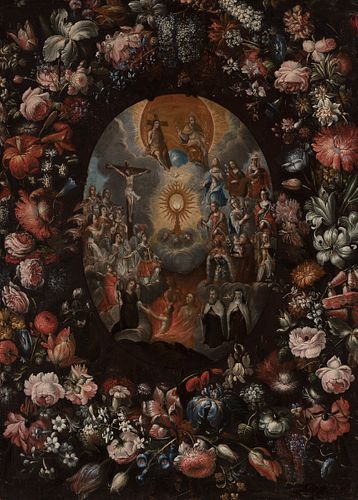Attributed to ANDRÉS PÉREZ (Seville, 1660- 1727). "Allegory of the Eucharist in a border of flowers". Oil on canvas. It has restorations and repaintin
Lot 155
About Seller
Setdart Auction House
Carrer Aragó 346
Barcelona
Spain
Setdart Subastas was born in 2004 and is currently the first online art auction in Spain with solidity, prestige and reliability guaranteed by our more than 60,000 users. Setdart has a young, dynamic and enterprising team ready to successfully manage the purchase and sale of art works through custom...Read more
Estimate:
EUR€38,000 - EUR€40,000
$40,860.22 - $43,010.75
Absentee vs Live bid
Two ways to bid:
- Leave a max absentee bid and the platform will bid on your behalf up to your maximum bid during the live auction.
- Bid live during the auction and your bids will be submitted real-time to the auctioneer.
Bid Increments
| Price | Bid Increment |
|---|---|
| EUR€0 | EUR€10 |
| EUR€200 | EUR€25 |
| EUR€500 | EUR€50 |
| EUR€1,000 | EUR€100 |
| EUR€3,000 | EUR€200 |
| EUR€5,000 | EUR€500 |
| EUR€10,000 | EUR€1,000 |
| EUR€20,000 | EUR€2,000 |
| EUR€50,000 | EUR€5,000 |
About Auction
By Setdart Auction House
Oct 20, 2021
Set Reminder
2021-10-20 07:30:00
2021-10-20 07:30:00
America/New_York
Bidsquare
Bidsquare : OLD MASTERS
https://www.bidsquare.com/auctions/setdart-auction-house/old-masters-7700
Setdart Auction House sofia@setdart.com
Setdart Auction House sofia@setdart.com
- Lot Description
Attributed to ANDRÉS PÉREZ (Seville, 1660- 1727). "Allegory of the Eucharist in a border of flowers". Oil on canvas. It has restorations and repainting. Measurements: 150 x 117 cm; 118 x 83 cm (frame). We see in this canvas a typical composition of the baroque period inherited from the Low Countries. It is a scheme that combines a garland of flowers, sometimes also of fruits, although not in this specific case, with a religious representation of devotional type in the interior. The artist combines the genres of religious painting and still life, seeking greater sumptuousness and a theatrical, almost trompe l'oeil-like sense, very much to the taste of Baroque painting. It should be noted that in this type of composition the flowers are not simply a secondary or accessory element, but are worked with the same care and quality as the religious image. In fact, on occasions they even reveal a more skilful hand, as these works were often the result of the collaboration between a painter of flowers and another who specialised in the human figure. In this particular work, great mastery can be seen both in the floral composition and in the scene depicted inside it. An image in which the Eucharist is glorified, as an ostensorium is placed in the centre, gilded, resplendent and with the sacred form inside. The scene is completed by a large group of figures, with the figure of God and his son standing out, both blessing, located in the upper area, inscribed in a break of glory. On the left, Christ crucified, accompanied by a choir of angels, and the figure of Justice, carrying a scale. In the lower area we see, among the flames, the figure of the good thief, who is being held by an angel, the bad thief, and the forsaken soul, a very popular representation in Andalusian painting. Finally, the scene is completed by several saints, including Saint Joseph, Saint Anthony and Saint Barbara, among others. Due to the technical characteristics, the representation of elements very typical of Andalusian art, and even of saints linked to Andalusia, this work can be aesthetically inscribed at the time when the Andalusian school reached its greatest splendour, both in terms of the quality of the works and the primordial rank of Sevillian Baroque painting. He was particularly linked to the painting of Andrés Pérez. There is little information on the biography of the painter Andrés Pérez, son of the painter Francisco Pérez de Pineda, of whom he was probably a disciple. According to Cean, despite the Murillesque influence of the period, Andrés Pérez possessed his own stylistic characteristics, such as a very precise drawing, characters of gentle expressiveness, and broad scenes reminiscent of architectural settings or landscape perspectives. The two most important known works by this painter are in the Seville Museum of Fine Arts and are attributed to Ortega and Lucas Valdés. His works have a markedly Eucharistic symbolism, perhaps due to his commissions for chapels.
- Shipping Info
-
In-house shipping available. Please inquire at admin@setdart.com.
-
- Buyer's Premium



 EUR
EUR CAD
CAD AUD
AUD GBP
GBP MXN
MXN HKD
HKD CNY
CNY MYR
MYR SEK
SEK SGD
SGD CHF
CHF THB
THB









